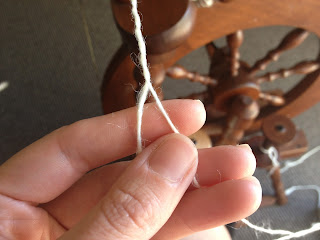This wool comes from the family farm. It's from the Romney bred of sheep and is a mid-micron weight. The fleece was washed and carded by Tai Tapu Wool carders, and then spun and dyed by me.
The width of the fibre is measured and expressed in microns. Because this is a mid-micron fleece, it lends itself to a medium weight yarn.
As is customary, I started by spinning a single thread, then plied then together by spinning two strands together.
That's my lovely old Ashford traveller spinning wheel in the background. I got it from an auction clearing house many years ago and it's so durable it will probably see me out.
I learnt to spin many years ago as a teenager. It's like riding a bike; once you learn you never forget how, no matter how many years intervene. If your keen to learn I suggest cruising the on-line auction sites for a second-hand bargain; as spinning wheels can vary in nature, you will want to stick to the same one until your confident and competent. Try finding an expert to help you learn. The majority of spinners tend to be woman in their 50s and 60s, and most are overjoyed to help a keen young learner.
This is my Lazy Kate. Its job is to hold the spools of wool during the plying process.
This is the finished plied wool on the spool.
The next step is to reel the wool off onto the Niddy Noddy. I have to confess I don't know the origin of the name. It is extremely effective.
Once its been coiled into a hank, its all ready for dying. I used Dylon dye sachets and followed the simple directions on the packet. I usually only dye a small amount at a time, and half a sachet is sufficient to get the result I want. Be careful to measure out the correct quantities as the mixture calls for precision.
My three finished hanks. I haven't decided what to knit with them yet. I want to add another lovely soft colour and work on a stripe inspired pattern. All in good time...






No comments:
Post a Comment